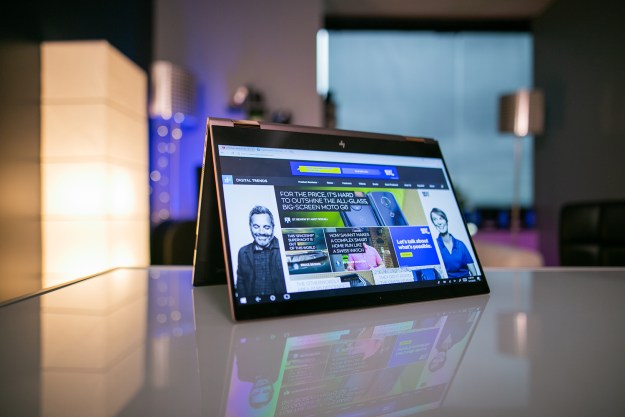
“The muscular HP Spectre x360 15-inch can’t handle a marathon.”
- Conventional but attractive design
- Great keyboard
- Excellent processor performance
- Fast enough for most games
- Too thick and heavy for tablet use
- Mediocre 4K screen
- Disappointing battery life
What do people want from a laptop, anyway?
That’s an easy question to answer, but an impossible question to answer correctly. There’s vast range of possibility, from the 12-inch MacBook to bulky 17-inch Inspirons to workmanlike 15-inch ThinkPads, and everything between. Compromise is inevitable.
Still, laptop makers want to have it all – which leads to flagship devices like the HP Spectre x360 15-inch. It’s a 2-in-1 with a big battery and an efficient processor. It’s also a cutting-edge technological showcase that can handle work and gaming with equal ease. It weighs 4.5 pounds, but packs a full-sized keyboard with numeric keypad. Even the port selection, which includes both USB-A and -C and a full-size HDMI connection, tries to serve every need.
HP’s hardly alone in this pursuit. Dell has the XPS 15 2-in-1, as well as several more affordable Inspiron options. Asus’ Flip line includes several 14- and 15-inch models. And Acer offers the Nitro 5 Spin, an affordable 2-in-1 with Nvidia GTX 1050 graphics. None of those have scored high marks in our reviews, however. Can the Spectre x360 15-inch buck that trend?
It’s a looker, if you bother to look
After years of bouncing between looks like a teenage pop star, HP has finally decided on a design language – for the Spectre brand, at least. The Spectre x360 15-inch, like its 13-inch brother, melds a simple matte metal finish with chromed bronze accents.
Metal construction is hardly unique, but the Spectre x360 15-inch has a sleek, sharp profile that defines itself from many competitors. That’s particularly true on close inspection. HP lavishes this Spectre with small touches, from a triangular pattern across the speaker grill, to halved-hexagon shapes that appear on the power buttons and rear of the hinges. You might not notice these touches at first, but you’ll appreciate them once you do.
Despite that, the Spectre x360 feels rather conventional in the day-to-day. The large display, combined with the full-sized keyboard and 0.7-inch thick chassis, mean this PC feels like, well, a PC. It’s not going to surprise you, but you might prefer that if you’re looking for a workhorse computer you’ll use all day instead of a super-sleek portable aimed primarily at mobility.
Port selection also spans new and old. Two USB-C ports with Thunderbolt 3 are paired with single USB-A and HDMI 2.0 ports and a full-size SD card slot. While we wouldn’t mind seeing more ports overall, this pairing of new with traditional ports makes the Spectre a bit easier to live with than Dell’s XPS 15 2-in-1, which goes all-in on USB-C and
Did anyone tell this Spectre it’s a 2-in-1?
The Spectre feels so conventional, in fact, that you might not suspect it’s a 2-in-1 if no one told you. The keyboard exemplifies that. While competitors like the Dell XPS 15 2-in-1 are experimenting with new key designs to minimize weight and size, the Spectre x360 15-inch has an entirely conventional, long-travel keyboard – and it feels great. Stranger still is the numpad which, well, exists. Most flagship devices, including the previous version of this laptop, don’t have one.
The Spectre feels so conventional, in fact, that you might not suspect it’s a 2-in-1 if no one told you.
We’re not as keen on the touchpad. It’s quite wide, but not all that tall. The Apple MacBook Pro 15 set a trend for massive touch surfaces, and most competitors have followed suite. HP is behind the curve here. To make matters worse, the Spectre’s touch surface felt finicky. It offered a poor sense of friction and occasionally failed to respond when expected.
HP might’ve skimped on the touchpad because there’s another touch surface – the screen. All versions of the Spectre x360 15-inch come with a multi-touch panel. It felt smooth and responsive when used in laptop mode. The real point of it, though, is tablet use.
Rotate the display all the way back and you’ll eventually turn this laptop in a tablet, though like most 2-in-1s with a 360-hinge, the Spectre can feel a bit awkward. The keyboard is always hanging out around back. That’s a small problem, however, compared to the big problem. This is a large and heavy device, with hard metal edges on all corners. It’s not pleasant to hold, which means it’s not a pleasant tablet. We can see using it to browse the web for a few minutes, but don’t mistake it for an iPad or Surface Pro substitute.

All large 2-in-1s have the same problems to a degree, but the Spectre is behind the pack. The Dell XPS 15 2-in-1 is smaller and lighter, so it doesn’t feel as unwieldy. The Microsoft Surface Book 2 is better still because the screen detaches entirely for tablet use and weighs only 1.7 pounds on its own.
HP’s Digital Pen comes standard with the Spectre x360-15 inch. It’s a functional but unimpressive stylus offering 1,024 levels of sensitivity. The HP Tilt Pen, which adds a tail-end eraser function, replaceable tips, and tilt control, sells for $90. There’s no place to attach the stylus except for a slot on the included protective sleeve, and so it’s easy to lose track of it — if you use it at all. We hardly did. The size and weight of the Spectre make note-taking a chore unless the 2-in-1 is placed on a desk or table – but then, why not just use the keyboard?
Super sharp, but lacking an edge
All versions of the HP Spectre x360 15-inch quadruple down on vitamin K. That’s
Its vivid colors are also immediately noticeable. Vibrant, high-quality content — like a
The screen’s contrast ratio came in at 830:1, which is respectable but far from class-leading. The Dell XPS 15 2-in-1, for instance, offers a ratio of 1,460:1. Dell achieves that on both ends of the spectrum; it’s even brighter but also has deeper black levels in dark scenes. The Spectre’s mediocre contrast means it doesn’t look as immersive and realistic as its peers.
The speakers, like the screen, stop short of greatness. They’re loud, clear, and deliver a good experience in most situations, but they struggle with treble when the volume edges over 90 percent. Voices start to crack or hiss, detracting from whatever you’re trying to enjoy. You can get by with the built-in sound, but external speakers make a night-and-day difference.
Feel the power
HP ships the Spectre x360 15-inch with two processor options. The common Core i7-8550U quad-core is standard, but our review unit came with the Core i7-8705G, a $120 upgrade. It slightly ups the maximum clock speed, but more importantly, it throws in AMD Radeon RX Vega M GL graphics. We’ll discuss that in a moment.
It’s a strong processor, of course. The Core i7 scored well on Geekbench’s single-core test and set a record for mainstream
These results show the Core i7-8705G isn’t just about AMD graphics. The Intel hardware benefits from the chip’s high design power. More power means more performance, so the Spectre x360 15-inch easily beats even the Microsoft Surface Book 2, which was among the fastest
The Spectre shares something else with the Dell. Heat. External temperatures can rise alarmingly at full tilt. Our IR thermometer measured a maximum of 126 degrees Fahrenheit on the bottom rear of the chassis. That’s hot enough to be painful, so keep it off your lap when the fans start to kick up.
Good enough for gaming
AMD’s Radeon RX Vega M GL graphics is the lesser of the two Intel/AMD collaboration chips available, but it remains an impressive piece of kit that promises performance on par with Nvidia’s GeForce GTX 1050. It’s an option, but one worth choosing, because it’s a big upgrade over the standard Nvidia MX150.
We’ve now tested two
They both have an advantage over the Acer Nitro 5 Spin, however, which packs a GTX 1050. That makes the Spectre x360 15-inch a respectable gaming machine at 1080p resolution. It can even handle the demanding Deus Ex: Mankind Divided at 1080p and High detail, scoring an average of 35 frames per second. Battlefield 1, meanwhile, achieves 44 frames per second at Ultra detail. At the same time, the Dell XPS 15 with its GTX 1050 Ti Max Q tends to run right along with the Spectre x360, meaning that the Radeon chip falls in between the GTX 1050 and full-speed GTX 1050 Ti, just as Intel and AMD predicted.
If you don’t mind 1080p, the HP Spectre x360 15-inch can serve as a capable gaming machine.
It’s not fast enough to take advantage of the
1440p, or 2,560 x 1,440 resolution, can be a good compromise for some games, but it’s not supported here. A missing 1440p option has plagued several recently tested
If you don’t mind 1080p, though, the HP Spectre x360 15-inch can serve as a capable gaming machine. You’ll have to turn down some settings in the most demanding games, but that’s true of any laptop not specifically built for gamers. We’re always happy to see mainstream
A big battery for a big laptop
A massive 84-watt battery powers the Spectre. That’s not the biggest we’ve seen, but it’s certainly up there. That’s about 10 percent larger than the 75-watt battery in Dell’s XPS 15 2-in-1, which is good, because the Dell struggled to last over the long haul. How did the HP fare?
Well, at least it beats the Dell.
The HP Spectre x360 lasted about six and a half hours in our web browsing loop, and barely more than three hours in our most demanding web benchmark loop. Those scores are noticeably better than the Dell XPS 15 2-in-1 but fall behind what we expect from a modern laptop.
Blame the hardware.
Our Take
The base HP Spectre x360 15-inch started at $1,370 when it was first introduced, though the configurations have shrunk since. Our review unit with an Intel Core i7-8705G, 16GB of
Is there a better alternative?
The Dell XPS 15 2-in-1 is the Spectre’s direct competitor. It has a better display and more eye-catching design, but HP delivers a better keyboard.
Microsoft’s Surface Book 2 is another option. It loses in CPU performance, but the 15-inch model is even faster in gaming and graphical test. It’s much more expensive but, unlike the XPS 15 2-in-1 or the Spectre x360 15-inch, it’s useful as a tablet.
How long will it last?
HP’s Spectre x360 15-inch has extremely fast hardware and will zip for years. Our only worry is the battery. Its endurance is only going to degrade over time. HP ships the Spectre x360 15-inch with the usual 1-year warranty. Extended warranties are available, starting at $240 for a 2-year protection plan.
Should you buy it?
No.
The HP Spectre x360 15-inch is full of cutting edge technology, but its 2-in-1 design disguises the machine’s old-school inspiration. This is a big, chunky, fast machine that works best when it’s used near a wall socket. Those disparate halves give the machine a split personality that doesn’t work in its favor.
Editors' Recommendations
- HP launches a new gaming laptop and HyperX accessories
- HP’s new Envy x360 14 looks like a killer value for what you get
- Asus’ 4K, 32-inch mini-LED gaming monitor might hit the perfect sweet spot
- Asus ZenBook S 13 Flip vs. HP Spectre x360 13.5: you can’t go wrong
- The HP Dragonfly Folio G3 brings back iconic pull-forward design






